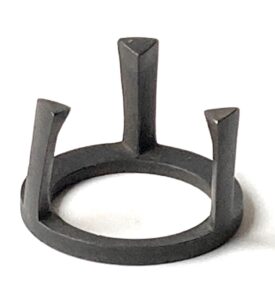Eight-Ten: Gotoku Lid Rest

Futa-oki, 蓋置, lid-place, go-toku, 五徳, five-virtues, Kara-kane, 唐銅, Tang-copper, bronze, with dark patina; h. 1.2 sun kane-jaku, diam. 2 sun kane-jaku. The gotoku is a ring of rectangular-section with three triangular posts or legs, and is used to support a kama no futa, 釜の蓋, kettle’s lid when removed from the kettle.
When the gotoku is displayed in the Tearoom, the posts/legs are upright with two posts at the front, shōmen, 正面, correct-face, as pictured above. When used to support the kama lid, the gotoku is turned over so that the ring is up, and with one post/leg forward. Being inverted, the posts are identified as ashi, 足, foot/leg.
The gotoku is an ancient utensil for supporting a vessel over a fire, or the stand of an oil lamp, etc. The gotoku is made in many sizes, and there are groups of nesting gotoku of graduated sizes. Sen no Rikyū chose a gotoku to support the lid of the kama when removed. A gotoku is used to support a kama in some fu-ro, 風炉, wind-hearth, and most often in the ro, 炉, hearth.
The structure of the pictured gotoku has some numerical associations, and symbolic significance identified with the Eki-kyō, I Ching, 易経, Change-sutra. The circular ring is identified with the negative aspect of In, 陰, Ying, receptive. Each post is identified with the positive aspect of Yō, 陽, Yang, penetrative. A triangle is also identified with Yō because the number 3 cannot be divided equally in half. The three three-sided posts/legs together have a total of 9 sides, and the number 9 is of supreme Yō. The ring of the gotoku has a cross-section of 4 sides, and the number 4 is identified with In because it can be divided equally in half.
The height of the standard futaoki is 1.8 sun kane-jaku. The number 18 in Japanese is jū-hachi, 十八, ten-eight. The two Kanji can be written together to create the Kanji ki, 木, tree, which is symbolic of ‘life’.
The pictured gotoku has a diameter of 2 sun kane-jaku, and the height each post/leg is 1.2 sun kane-jaku. In my pursuit of finding the relevance of the number 18 in Tea utensils, I found that the number 18 may be ‘hidden’ in the measurements of the gotoku. The height of each post/leg is 1.2 sun kane-jaku, and when the three are added together, the total is 3.6 sun kane-jaku. A math-minded person would readily see that 36 is 18 doubled. Perhaps the determinant is the 2 sun kane-jaku diameter of the gotoku ring. This dual aspect of numbers may be reflected in the dual nature of the gotoku: upright and inverted, 18 and 18.
For further study, see also: Furo to Ro, Furo to Ro: Three Forms, and Jizō and the Gotoku

